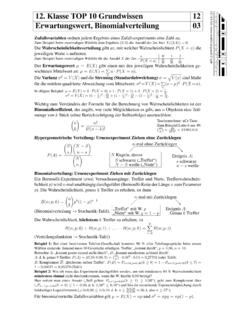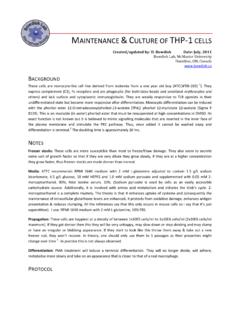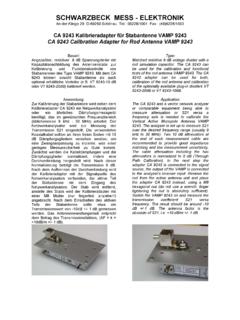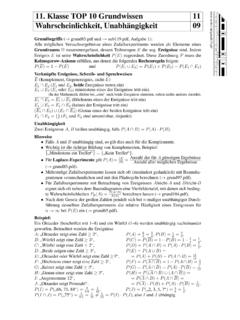Transcription of A new classification of foods based on the extent …
1 Cad. Sa de P blica, Rio de Janeiro, 26(11):2039-2049, nov, 20102039A new classification of foods based on the extent and purpose of their processingUma nova classifi ca o de alimentos baseada na extens o e prop sito do seu processamento1 Faculdade de Sa de P blica, Universidade de S o Paulo, S o Paulo, Faculdade de Medicina, Universidade de S o Paulo, S o Paulo, N cleo de Pesquisas Epidemiol gicas em Nutri o e Sa de, Universidade de S o Paulo, S o Paulo, Instituto de Nutri o, Universidade do Estado do Rio de Janeiro, Rio de Janeiro, World Public Health Nutrition Association, Rio de Janeiro, A. MonteiroDepartamento de Nutri o. Faculdade de Sa de P blica Universidade de S o Paulo.
2 Av. Dr. Arnaldo 715, S o Paulo, SP 01246-904, Augusto Monteiro 1 Renata Bertazzi Levy 1,2 Rafael Moreira Claro 3In s Rugani Ribeiro de Castro 4 Geoffrey Cannon 5 AbstractThis paper describes a new food classification which assigns foodstuffs according to the extent and purpose of the industrial processing applied to them. Three main groups are defined: unpro-cessed or minimally processed foods (group 1), processed culinary and food industry ingredi-ents (group 2), and ultra-processed food products (group 3). The use of this classification is illustrat-ed by applying it to data collected in the Brazilian Household Budget Survey which was conducted in 2002/2003 through a probabilistic sample of 48,470 Brazilian households.
3 The average daily food availability was 1,792 kcal/person being from group 1 (mostly rice and beans and meat and milk), from group 2 (mostly vege-table oils, sugar, and flours), and 20% from group 3 (mostly breads, biscuits, sweets, soft drinks, and sausages). The share of group 3 foods increased with income, and represented almost one third of all calories in higher income households. The impact of the replacement of group 1 foods and group 2 ingredients by group 3 products on the overall quality of the diet, eating patterns and health is Processing; Nutrition; Feeding BehaviorIntroductionIt is generally acknowledged that increased pro-duction and consumption of industrially pro-cessed foods and drinks is an important cause of the current pandemics of obesity and related chronic diseases 1,2.
4 However, dietary assess-ments, and dietary recommendations typically use classifications of food (and of drink, here in-cluded as food ) that largely ignore or minimize the significance of industrial food processing. The significance of food processing in itself, is this way, foods with very different nutri-tional profiles and impacts on eating patterns and health, such as whole grains, breakfast cere-als, flours, breads, cookies, crackers, and cereal- based snacks such as power bars , are classified within the same food group of grains or cereals and cereal products. The same applies to whole fresh fruits, sugared canned fruits, and reconsti-tuted sugared fruit beverages (classified within fruits) as well as to fresh meat, chicken and fish, and processed products such as burgers, nug-gets and fingers (classified within meat or meat and meat products).
5 Such classifications, derived from the big four (or five ) groups originally devised early last century, still dominate official and other authoritative information and educa-tion programmes, accounts of population di-etary patterns, and reports designed to prevent diseases that are influenced by diet 3,4,5, ARTICLEM onteiro CA et Sa de P blica, Rio de Janeiro, 26(11):2039-2049, nov, 2010 Because food processing is minimized, un-clear or ignored in such classifications, the gen-erally accepted literature includes only fragmen-tary information about and insight into the rela-tionships between processed foods , and eating patterns, energy and nutrient intake, and health.
6 Some conclusive evidence has emerged on proc-essed meats and certain types of cancer 2 as well as on sugar-sweetened soft drinks, energy intake, and obesity and diabetes 2,7,8,9,10. Some evidence exists, though it is still incomplete, on fast foods and snacks, and obesity 2,11. But the focus so far has been on the effect only of specific types of processed foods , and not on the overall pattern of processed food production and a previous commentary 13 we have pointed out that a classification of foodstuffs into only two categories, unprocessed and processed, is of little use, since nowadays in both higher-in-come and lower-income countries and contexts practically all food is processed in some way.
7 We also have proposed that the extent and purpose of food processing should be considered crucial determinants of the influence of foods on eat-ing patterns and the overall quality of diets, given their implications for public and personal health and the risk of disease this paper we outline a new food classifica-tion which groups foodstuffs according to the ex-tent and purpose of the industrial processing ap-plied to them. The new classification is designed as a tool to describe food systems and dietary patterns, and how these may affect health and the risk of disease. As a first illustration, we have applied the classification to describe the relative contribution of food groups to the overall and income-specific household food availability in new food classificationFood processing is defined here as all methods and techniques used by the food, drink and as-sociated industries to turn whole fresh foods into food products.
8 The methods used by farmers and producers in cultivating plants and raising ani-mals also affect the nutritional and other quali-ties of whole foods 13, but these are not consid-ered classification used in this paper assigns foodstuffs to three groups according to the ex-tent and purpose of the processing used in their 1: unprocessed and minimally processed foodsThe first group includes unprocessed and mini-mally processed foods . Minimal processes are mostly physical. These are applied to single basic foods with the purpose of preserving them and making them more available and accessible, and often safer and more palatable.
9 These processes include cleaning, portion-ing, removal of inedible fractions, grating, flaking, squeezing, bottling (in itself ), drying, chilling, freezing, pasteurization, fermentation, fat reduc-tion, vacuum and gas packing, and simple wrap-ping. They may be used by the primary producer, packing house, distributor or retailer, as well as by manufacturers, for eventual sale to consum-ers. Fresh meat and milk, grains, legumes, nuts, fruits and vegetables, and roots and tubers sold as such are usually minimally processed in vari-ous ways. Teas, coffee, herb infusions, tap wa-ter and bottled spring water also belong to this 2: processed culinary or food industry ingredients The second group includes substances extracted and purified from unprocessed or minimally pro-cessed foods in order to produce culinary and/or food industry and also chemical processes such as pressure, milling, refining, hydrogenation and hydrolysis, and use of enzymes and additives, are employed.
10 These processes are different from those used to obtain minimally processed foods , in that they radically change the nature of the original , foodstuffs in group 2 are inedible or unpalatable by themselves, and have higher energy density and lower nutrient density com-pared with the whole foods from which they were extracted. They are used in homes or restaurants, in the preparation and cooking of dishes made up of fresh or minimally processed foods (group 1), and also in the industrial development of ultra-processed products (group 3, see below). Group 2 foods include common food industry and cu-linary ingredients such as starches and flours, oils and fats, salt, and sugar and sweeteners, and, also, industrial ingredients such as high fructose corn syrup, lactose, and milk and soy proteins.

















